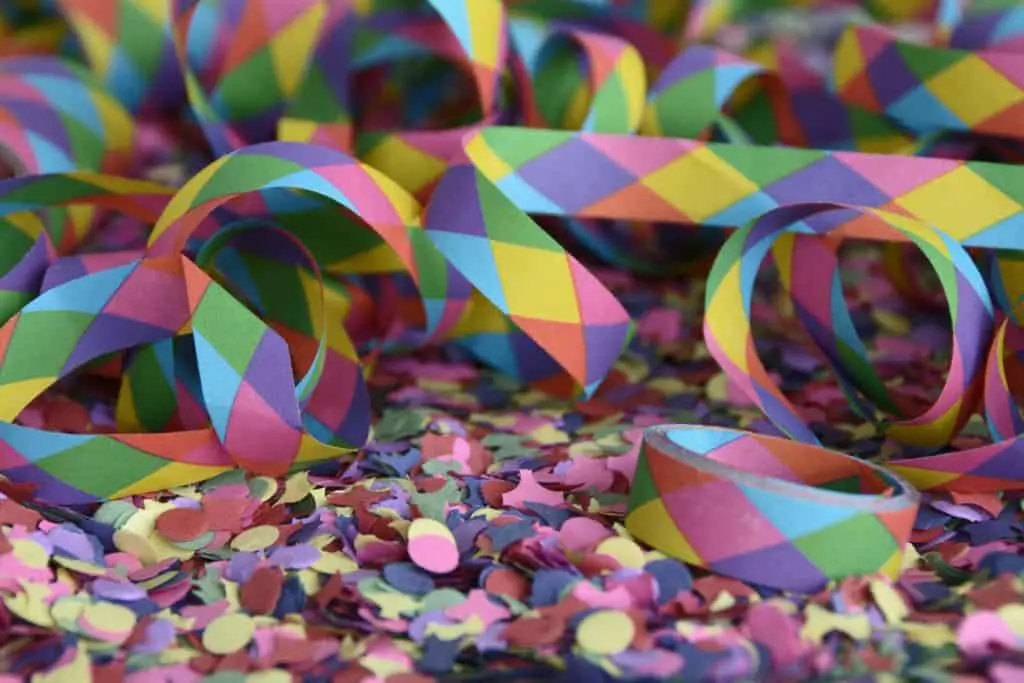When’s the last time you went to a celebration and you didn’t see any balloons?
It’s probably been a while. Balloons are a staple at all kinds of celebrations, from birthday parties to grand openings to retirement parties and more.
And it’s not that difficult to understand why. Balloons are a fun decoration for any event.
Children in particular absolutely love balloons. They love hanging on to them, watching them get twisted into balloon animals, or even using them to engage in water balloon fights.
Unfortunately, while the use of balloons may seem fun in the moment, they can actually be quite harmful to the environment.
In this article, we will take a detailed look at the harmful environmental impact of balloons.
What’s more, we will also show you 6 eco-friendly alternatives that you can use instead of balloons.
When Were Balloons Invented?
You might not realize this, but balloons have been around for quite some time. The very first balloons were made out of dried animal bladders – often pig bladders.
The Aztecs may have been the first to use balloons. They used cat intestines to create balloon sculptures.
The novel Swiss Family Robinson also contains one of the earliest references to balloons, mentioning that they were made from whale intestines.
The First Rubber Balloons
The balloon as we know it today can be traced back to 1824, when a scientist named Michael Faraday invented the first rubber balloon.
He did this by laying two pieces of rubber on top of each other and pressing their edges together. He would cover the rubber sides facing each other with flour to prevent them from sticking to each other.
The First Commercially Sold Balloons
Rubber balloons grew in popularity after Thomas Hancock found a way to sell them to the public.
He was a rubber manufacturer who sold balloons in the form of DIY kits, which included a latex rubber solution and a condensing syringe that you would have to use to make your own balloons.
It wasn’t until the 1930s that balloons were mass-produced. Tracking how many balloons are produced on a daily basis across the world isn’t possible – but it’s estimated that roughly 45 to 50 million balloons are sold in the state of California alone on a yearly basis.
Are There Any Eco-Friendly Balloons?
The short answer is: no. There is no such thing as an eco-friendly balloon.
First of all, they are not biodegradable. Secondly, they pose a serious threat to wildlife.
Because of the fact that they don’t degrade (and because so many balloons are sold every year), balloons will only continue to grow into a bigger and bigger problem for wildlife around the world.
Balloons Can Cause Suffocation & Intestinal Problems
Arguably the biggest issue when it comes to balloons is that they pose a serious threat to wildlife. When a balloon is deflated or has popped, it can easily be mistaken for potential food.
On land or in the sea, birds, smaller animals, and marine life may attempt to consume deflated balloons. If they manage to swallow the balloon without suffocating, then they will likely cause any number of other issues.
Balloons cannot be digested, which means that they will typically cause stomach or intestinal blockages. This, in turn, can lead to starvation.
A recent study revealed that balloons were responsible for the deaths of more birds than any other type of consumed debris. An estimated 20 percent of all seabirds that ingested balloons or balloon fragments died as a result.
Balloon Strings and Ribbons Cause Entanglements
If suffocation and intestinal blockages weren’t horrible enough, the strings or ribbons that are often attached to the rubber balloons pose a serious threat as well.
These strings or ribbons ensnare wildlife, restricting their movement and thereby reducing their ability to feed and survive.
Entanglements have been known to cause everything from infections and amputations to drowning and starvation.
Can Balloons Be Recycled?
Here’s another short answer: No, balloons are not recyclable.
There are two main types of balloons that are sold – mylar balloons and latex balloons.
Neither of them can be recycled, which is one of the reasons why balloons are far from eco-friendly.
Are Mylar Balloons Recyclable?
Mylar balloons are very common. While you may not be familiar with the term “mylar,” you’ve certainly seen mylar balloons around.
They are the foil balloons that you purchase already filled up with air or helium (commonly available at party stores and pharmacy stores). They are made using synthetic nylon or polyethylene and metallic coating.
They are not biodegradable in any way, which means that they are the most eco-unfriendly balloons that you can purchase.
Are Latex Balloons Recyclable?
This is where things get a little tricky. Natural latex is considered a biodegradable material, which means that it should be recyclable.
Natural latex is made from rubber tree sap and is completely biodegradable – however, latex balloons do not use “natural” latex.
This means that companies advertising their latex balloons as being “biodegradable,” “recyclable,” or even “eco-friendly,” are misleading at best.
The reason that latex balloons are not completely biodegradable is that they use processed latex along with any number of preservatives, color dyes, chemicals, and plasticizers.
As such, these latex balloons can take upwards of six years to decompose, giving animals plenty of time to suffocate on them or to ingest them. Even if a latex balloon remains unfound by nearby wildlife, it still won’t completely degrade.
Is It Dangerous To Release Helium Balloons?
Balloons used to be filled with hydrogen, but hydrogen is explosive and therefore an incredibly serious safety hazard. These days, balloons are filled with either air or helium.
Why Is Helium Used in Balloons?
Helium tends to be the go-to choice for most balloons (especially for special occasions that have balloon release events) because of how light it is.
Helium is much less dense than air, which is why it will float upwards. A liter of air weighs around one gram, whereas a liter of helium weighs around 0.1785 grams.
Balloons with air in them don’t float. This means that technically, helium is more dangerous than air because of the fact that helium-filled balloons are more likely to get entangled in power lines or become litter (and a hazard to nearby wildlife).
Is Helium Eco-Friendly?
At this point, we know that the materials used to make the balloons themselves are not eco-friendly.
However, what about the helium used in balloons?
Filling balloons with oxygen is fine – oxygen is readily available, after all. The same can’t be said about helium.
Helium in itself is a byproduct of natural gas processing. While this should be reason enough to stay away from using helium-filled balloons, there may actually be a bigger reason to avoid them: helium is a non-renewable resource.
Helium Balloons Are Wasting an Incredibly Valuable Resource
It’s a bit ironic that helium is the second most abundant element in the universe, yet it’s extremely rare on earth.
Helium on earth is created by the natural radioactive decay of heavy radioactive elements, such as uranium. Once helium is released, it will keep traveling up until it escapes the atmosphere.
It’s estimated that the balloon industry uses roughly five to seven percent of the total helium usage. This may not seem like a lot, but there are much more important things that helium should be used for.
For example, helium is required for MRI scanners, which can’t operate without liquid helium. Liquid helium is also required for the study of quantum effects. Many of the latest scientific discoveries wouldn’t have been possible without liquid helium.
Knowing this, should we really be wasting such a valuable, finite resource on balloons?
What Happens After You Let a Balloon Go?
What do you think happens when you let a balloon go into the sky?
It doesn’t just disappear without a trace.
Unfortunately, balloons aren’t just a hazard to wildlife once they deflate or burst.
They pose other serious problems as well, from contributing to the world’s growing litter problem to causing massive power outages.
Balloons Cause Serious Litter Problems
Balloons can travel a long way before they deflate, which means that if you let a balloon go in the city, it’s not just going to land on a sidewalk somewhere, thereby allowing someone else to just toss it into the trash.
First of all, a helium-filled balloon can travel six miles (10 km) into the atmosphere before popping.
Secondly, they can travel an incredible distance before they ever reach that height.
In 2013, a British schoolboy released 300 helium balloons as part of a school project. One of his balloons wound up in Australia – 10,545 miles away.
The remains of balloons can be found everywhere littering the landscape, from trees to oceans to beaches. In fact, it’s estimated that roughly 31,000 ballons are found along U.S. beaches every year.
In Virginia alone, almost 5,000 pieces of balloon litter were found from 2010 to 2014 along the coast.
In the UK, the Marine Conservation Society recently suggested banning balloon releases after revealing that the amount of balloon litter found on beaches in the UK increased over 50 percent from 2015 to 2016.
Balloons Cause Power Outages
Besides the fact that balloons eventually pop or lose their ability to float and come down to earth where they contribute to an increasingly severe litter problem, balloons can actually pose a serious safety hazard while still up in the air as well.
This is because balloons (specifically, mylar balloons) can become entangled in powerlines.
Because mylar balloons have a metallic coating, they can cause power outages if they come into contact with powerlines. In fact, this happens way more than you might realize.
According to Southern California Edison (an electric company), mylar balloons accounted for 942 power outages in their service area – in 2016 alone!
Power outages can be incredibly dangerous for all kinds of reasons.
For example, losing heat in the middle of winter or losing air conditioning in the middle of summer can both result in life-threatening situations for some people.
Are Balloons Safe for Children?
We already know that balloons aren’t exactly safe for wildlife, but what about children?
Parents often buy balloons for their children’s birthday parties or for their general entertainment (toddlers love balloon animals, after all), but are they safe for kids to play with?
Not really, actually. Balloons pose a serious choking hazard.
Uninflated balloons or pieces of a popped balloon pose a serious suffocation risk because of the way that they stretch and mold to the throat of a child, thereby cutting off their ability to breath.
Balloons Cause Child Deaths Every Year
The number of balloon-related choking incidents involving children every year is much higher than you might imagine. Of all of the toy-related choking deaths that were reported between 2001 and 2014, around 38 percent involved balloons.
These choking incidents often happen when a child is too young to know better and tries to swallow a piece of a balloon. It can also happen if a child accidentally swallows a balloon while trying to suck helium out of it or while attempting to blow it up.
Are Sky Lanterns Safe a Better Alternative to Balloons?
Sky lanterns are often used as an alternative to traditional balloons because of their stunning beauty.
There’s nothing quite like seeing dozens of glowing balloons floating through the air at night, after all.
Sky lanterns are often marketed as biodegradable because they are made out of treated paper.
There is an opening at the bottom of these paper balloons where a small fire is suspended.
Basically, sky lanterns are tiny hot air balloons.
It’s true that sky lanterns can be built out of eco-friendly materials, although they often are not.
They generally use small candles in order to generate the heat needed to fly.
Candles are usually not eco-friendly at all.
For example, paraffin candles are made from petroleum products and produce harmful byproducts, such as carbon dioxide.
Even the wicks used by these candles are commonly made using additives such as lead and zinc.
Why Are Sky Lanterns Dangerous?
A sky lantern can travel for miles, especially on a windy night, which means that there’s no way to be certain as to where it might land.
They have been known to cause both serious structure fires and environmental fires, not to mention that they can severely burn and kill both humans and animals.
Even if the fire is blown out before a sky lantern lands (or upon impact), animals can attempt to eat what remains and suffocate or become entangled as a result.
The FAA has even voiced concerns regarding how fire lanterns could potentially be sucked into the engine of a passing airplane!
Considering how dangerous they can be, it’s no surprise that over a dozen states have banned their use.
Even entire countries have banned sky lanterns, including Germany, Spain, Austria, Brazil, Australia, Chile, Colombia, New Zealand, and Costa Rica.
6 Eco-Friendly Alternatives to Balloons
It’s unfortunate that there aren’t balloons available that are 100 percent eco-friendly and safe; after all, they do bring a sense of joy to an event or celebration.
However, there are plenty of alternatives that can have the same effect as a balloon, whether it’s for decorative purposes, celebratory purposes, or pure fun.
The following are six examples of eco-friendly alternatives to balloons:
1. Pinwheels

Pinwheels are basically handheld windmills made out of paper. You can make them out of colorful biodegradable paper and pin them to eco-friendly paper straws.
Pinwheels can be held out into the wind to make the paper wheels spin, or they can be attached throughout an event space in the same way that you would decorate with balloons.
If you want to buy durable pinwheels that you can use to decorate your yard and that will last forever, look into buying some garden spinners.
2. Bubbles

Bubbles are arguably more fun than balloons since you have the immediate satisfaction of being able to blow the bubbles yourself. There’s nothing as exciting (for both kids and adults) as blowing a particularly large bubble!
While you might be worried about the environmental impact of blowing bubbles, there are eco-friendly options that you can buy.
You can even make your own bubbles by simply combining water with eco-friendly dish detergent and vegetable glycerin (honey is a suitable alternative to vegetable glycerin as well).
3. Flags

If you’re holding an event outdoors, then setting up some flags is a great way to celebrate the occasion – especially on a particularly windy day.
4. Streamers and ribbon dancers

If you’re throwing a surprise party or a celebratory event, then streamers are a great alternative to balloons. Not only can you release them from above like you would a room full of balloons, but you can use them as a colorful decoration.
There are plenty of eco-friendly streamers available that you can recycle once you used them.

If you’re trying to make a big statement (such as a congratulatory party, a birthday party, a retirement party, etc), then using bunting or banners to declare what the event is can have a much bigger impact than having a few scattered balloons.
6. Kites

Children love playing with balloons because of how they float in the air. We get it, it’s fun to play with a balloon.
However, flying a kite can be just as much fun – if not more so. And once you buy a nice kite, you can keep it forever!
Avoid balloons and use eco-friendly alternatives instead
When it comes down to it, balloons are just bad news all around. Balloons are:
- Not biodegradable
- A big contributing factor to litter around the world
- Wasting helium, a valuable, non-renewable resource
- A safety hazard for children
- A serious threat to the lives of wildlife
Because of these serious drawbacks, we strongly recommend you skip the balloons and pick up some eco-friendly alternatives for your next celebration or event instead.
You Might Also Like…
- Is Fast Food Bad for the Environment? (& What You Can Do)
- Is Fabric Softener Bad for the Environment? (+5 Eco-Friendly Options)
- Is Fuel Dumping Bad for the Environment? (& How Often It Happens)
- Is Electricity Generation Bad for the Environment? (What You Should Know)
- Is Dry Cleaning Bad for the Environment? (4 Surprising Facts)
- Is Diamond Mining Bad for the Environment? (Important Facts)
- Is DEET Bad for the Environment? 4 Effects (You Should Know)
- Is Cat Litter Bad for the Environment? (5 Common Questions)
- Is Burning Cardboard Bad for the Environment? (6 Facts)
- Is Burning Paper Bad for the Environment? (6 Surprising Facts)
- Is Burning Leaves Bad for the Environment? (7 Quick Facts)
- 4 Natural Cleaners for Quartz Countertops
- 6 Eco-Friendly Acrylic Paint Brands (For Sustainable Artists)
- 5 Eco-friendly Alternatives to Acrylic Paint (& How to Make Them)
- Is Acrylic Paint Bad for the Environment? (7 Quick Facts)
- Is Acrylic Yarn Bad for the Environment? 8 Crucial Facts
- Is Acrylic Bad for the Environment? (8 Quick Facts)
- Is Aluminum Foil Bad for the Environment? 7 Quick Facts
- Is Bleach Bad for the Environment? 6 Crucial Facts
- Is Lithium Mining Bad for the Environment? 6 Crucial Facts































